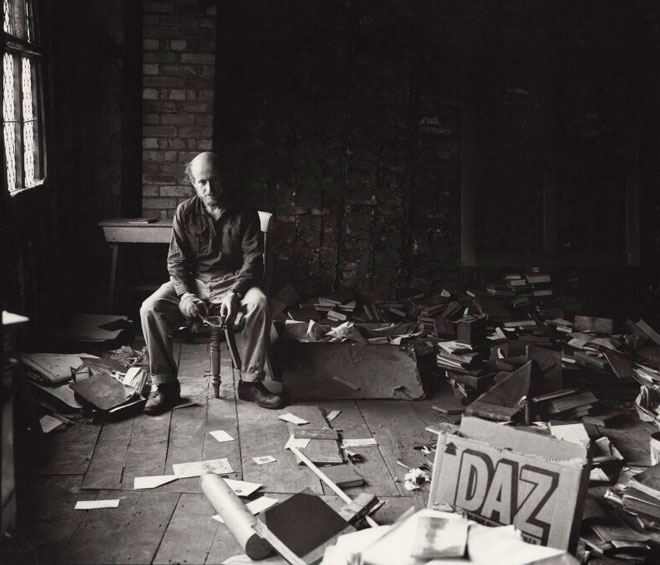
Gustav Metzger practicing for a public demonstration of Auto-destructive art, possibly by John Cox, for Ida Kar, 1960. © National Portrait Gallery, London.
Fermoy Gallery, King’s Lynn
29 June – 3 August 2019
by CATHERINE MASON
An exhibition at the Fermoy Gallery, as part of the King’s Lynn Festival Norfolk, gave a fascinating glimpse into the origins of Gustav Metzger’s art and ideas. The ideas regarding social responsibility and the role of art that he formulated in the 1950s while he lived in King’s Lynn led him to invent auto-destructive art and auto-creative art in the 60s. Ten years after leaving King’s Lynn, he devised plans for arguably his most ambitious project – Five Screens with Computer – participated in the groundbreaking exhibition Cybernetic Serendipity (1968), joined the Computer Arts Society and published articles about art and technology in Studio International. This exhibition got me thinking about the artist’s journey from painting abstracts influenced by David Bomberg to defining a new aesthetic using technology, fused with his agenda of social engagement and personal ethics. It covers a period that saw great social, economic and technological change in Britain, and Metzger addressed it all.
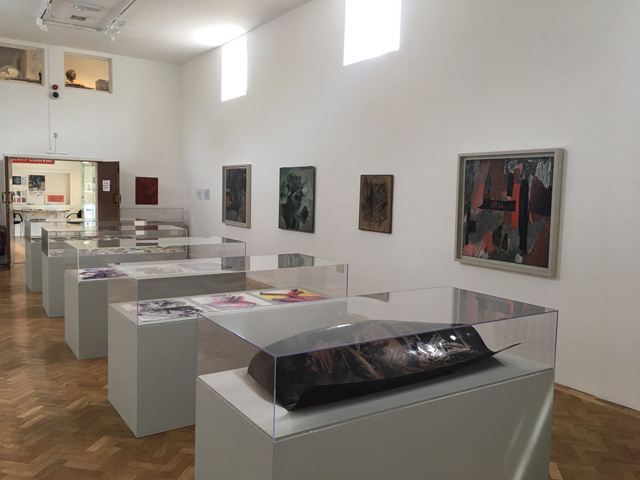
Destroy, And You Create: Gustav Metzger in King’s Lynn. Installation at Fermoy Gallery, King’s Lynn, Norfolk 2019. Photo: Catherine Mason.
Gustav Metzger (1926-2017) was a Polish Jew born in Nuremberg who witnessed at first hand the massing of Nazi forces during his childhood. He arrived in Britain in 1939 with his brother as part of the Kindertransport, but his remaining family was annihilated in the second world war. Due to these early experiences, throughout his life Metzger was particularly aware of the militaristic origins of much computing technology and regularly addressed these concerns in his artwork and writings.
After a stint at Cambridge School of Art, Metzger studied with Bomberg (1890-1957) at Borough Polytechnic in London. Andrew Wilson has argued that Bomberg was a profound influence on Metzger’s early work, particularly the prioritising of destruction within drawing and belief in an art as an embodiment of a social force. After a disagreement with Bomberg, however, Metzger wanted to get away from London and moved to King’s Lynn in 1953 for a period of about eight years.
During this time, Metzger produced approximately 15 oil paintings (most of which are in the collection of the Tate). This exhibition presented an additional quantity of paintings and numerous sketches that were rediscovered in a loft in 2012 and was the first show devoted to the early decade of the artist’s practice. These rarely seen items formed the exhibition, along with a selection of ephemera from this period and a recreation of Mass Media: Today and Yesterday (1972-2019), a participatory work using thousands of newspapers from which visitors can select articles and images. Throughout his life, Metzger was very aware of the power of news, stating: “Newspapers are reality; they represent reality; they also shape reality.”
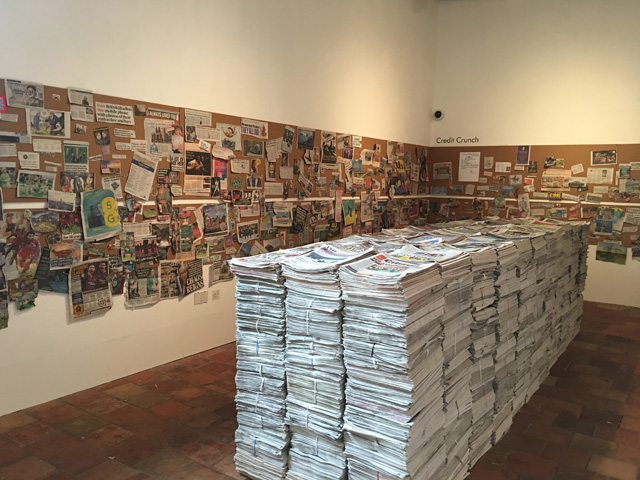
Gustav Metzger, MASS MEDIA: Today and Yesterday, 2011, installation Red Barn Gallery, King’s Lynn 2019. Photo: Catherine Mason.
In the 50s, King’s Lynn was a very much a quiet, country town with about 25,000 inhabitants (against about 40,000 now). The River Great Ouse runs through it and empties into the sea at the Wash. The town’s historic livelihood is therefore bound up with maritime trade: during the middle ages, it was the most important port in England. For centuries, the main social event was the Tuesday market founded in 1146. By the 50s, this market was flourishing.
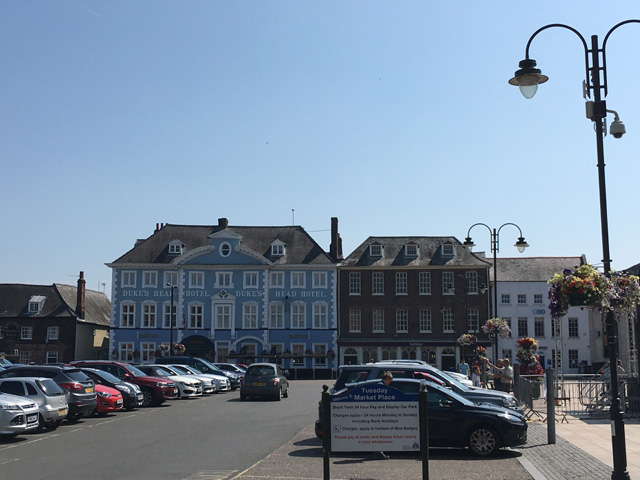
Tuesday Market Place - now a car park, but much of the historic architecture remains including the original 19th-Century Corn Exchange and Duke’s Head Hotel, c1680s. Photo: Catherine Mason.
Metzger initially supported himself by running a market stall selling bric-a-brac and books and repairing furniture and miscellaneous items. Older residents recall him going about the town collecting items in a barrel to sell on Tuesdays. Middle-class ladies would also give him items to sell, as an act of charity. On Saturdays, he went to nearby Cambridge and ran a secondhand book stall at the market there. By 1957, he had a shop, Thirty-Queens, selling antiques, books, drawings, paintings and sculpture in Queen Street. Here, he put up posters in the window promulgating his thinking on art and mounted small exhibitions of his friends’ work. For example, he displayed posters from the This is Tomorrow exhibition at the Whitechapel Gallery in 1956, an inspiring exhibition to which he made several visits, and exhibited small works by his friends Eduardo Paolozzi and William Turnbull – members of the Independent Group who organised This is Tomorrow and shared an interest in the critique of modern life through interdisciplinary means.
-c.jpg)
Gustav Metzger, Untitled Painting (Abstract) c1958. Oil on Kodak box. Courtesy Estate of Gustav Metzger. Photo: Catherine Mason.
Several of Metzger’s paintings from this time are on found supports – cardboard pieces, magazine and newspaper pages. Partly explained by his poverty, their use can also be seen a comment on postwar capitalism. (A later exhibition in London in 1959, Cardboards selected and arranged by G Metzger, displayed cardboard from television packaging without any painting on them, a type of ready-made.) In several, the subject is a table that Metzger bought at auction and these are similar to the Tate series. Strong, jagged marks at times make it seem as if he is attacking the canvas with palette knife and fingers. This type of mark-making will reappear later, in his acid paintings.
Metzger’s home was to the rear of an old building – St Nicholas House in St Nicholas Street, where he lived without paying rent. He established a local CND group, campaigning against rocket bases in East Anglia, and refined his ideas of how art can be social engaged, latterly experimenting with his first auto-destructive artwork. It was here that two events occurred that had a great impact on Metzger’s development as a person and an artist. He later said: “Everything I know about activism, I learned in King’s Lynn.”
.jpg)
St Nicholas House with door dating from the late 15th-century. Part of this building was lived in by clergy. After Metzger’s time it was converted into a hotel, and is currently being converted into townhouses. Photo: Catherine Mason.

Rear of St Nicholas House, showing Metzger’s studio on the ground floor, with living quarters above. Photo: Catherine Mason.
The first was Treasures From East Anglian Churches, an exhibition consisting of sacred relics that he organised in 1957, as part of the King’s Lynn Arts Festival. The venue, 3 Crowns Yard, was located opposite his antiques shop in the undercroft space of a 14th-century merchant’s house known as Clifton House. This house was historically owned by wine merchants, who would have used the basement to store barrels, the town in its heyday being a major centre for wine importation into England. One of the aims for the show, as stated in the festival catalogue, was to make the public more widely aware of the historic medieval architecture of the town. Metzger travelled throughout East Anglia collecting sculpture and stained glass, including Romanesque gargoyles from Norwich Cathedral, an angel head in coloured glass and an ancient stone cover for a heart burial from a church near Peterborough. Many of the items on view were mutilated or defaced during the English Reformation or by 16th-century Puritans; other items such as the angel head, survived intact, probably due to chance. While this demonstrated the effects of violence and destruction on artefacts, Metzger was refining his ideas about the role of destruction in creation. As curator of the present exhibition, Elizabeth Fisher, has stated, in Metzger’s eyes, the relics rather than being diminished by being defaced had acquired a greater symbolic value as a result of the destruction.
This exhibition marked the beginning of his interest in the relationship between destruction and creation. Alongside this, a shocking thing happened in his neighbourhood. It was to be his first major political event, although ultimately it proved a source of sadness as he felt he had failed.
Opposite Metzger’s house is an ancient church – St Nicholas Chapel (built 1380-1420) in an area known as the North End. Metzger would have known well the close-knit community of fishermen and the built environment centred on Pilot Street, which runs behind the church, and at that time included small cottages, pubs, inns, a bakery and smokehouses. Most of the fishermen were inshore (and did not go into deep sea), and fished for shrimp, herring, cockles, mussels and samphire. Metzger recognised the great culture and heritage of this area and believed the community to be 800 years old. (For example, the composer Vaughan Williams collected old folk songs in the town, which had a marked influence on his music).
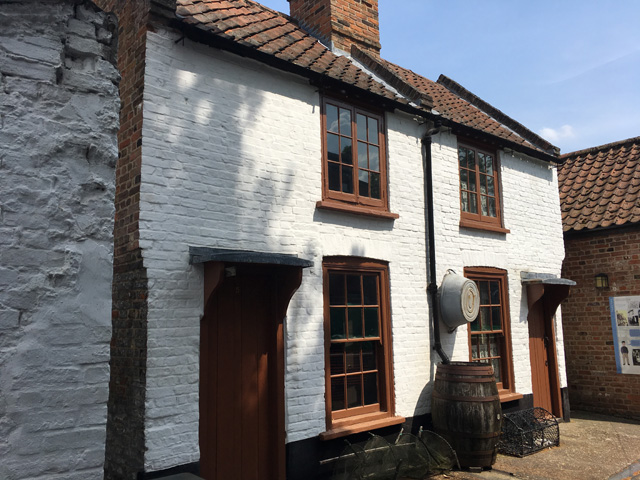
Two North End brick cottages dating from 1790, consisting of two rooms, one upstairs and one down – these remain today as True’s Yard museum. Photo: Catherine Mason.
In 1957-58 the borough council decided to construct a new road, which would necessitate the knocking down of the buildings of the North End and the destruction of this community. Metzger took up the cause, starting the North End Society to campaign against this. This was part of the modernisation of the town and the so-called slum clearances of the 1960s (which took place all over urban Britain) and to facilitate modern transport getting to and from the docks. This self-sufficient fishing community consisted of hundreds of families with its own boat-builders, chandlers, sailmakers, and a dairy and school. They led an often-hard life with no running water, no electricity and no drainage and very limited cooking facilities.
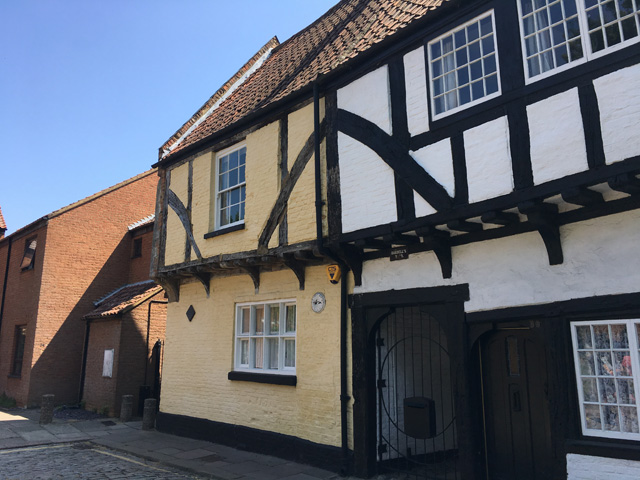
Old and new. The heart of the North End community was Pilot Street, the main thoroughfare which goes down to the Wash. More than 300 people lived here. Present site is one third of the original length. 1960s built houses shown on far left. Photo: Catherine Mason.
A photograph from the local paper shows Metzger in Pilot Street discussing the proposal with the president of the Chamber of Trade under the heading Conflicting Interests. Metzger calls for the area to be preserved as residential and to keep its character, arguing that if it were renovated, it would look less like a slum. For someone who was famously very quietly spoken, even shy, this demonstrates Metzger’s passion for this cause.
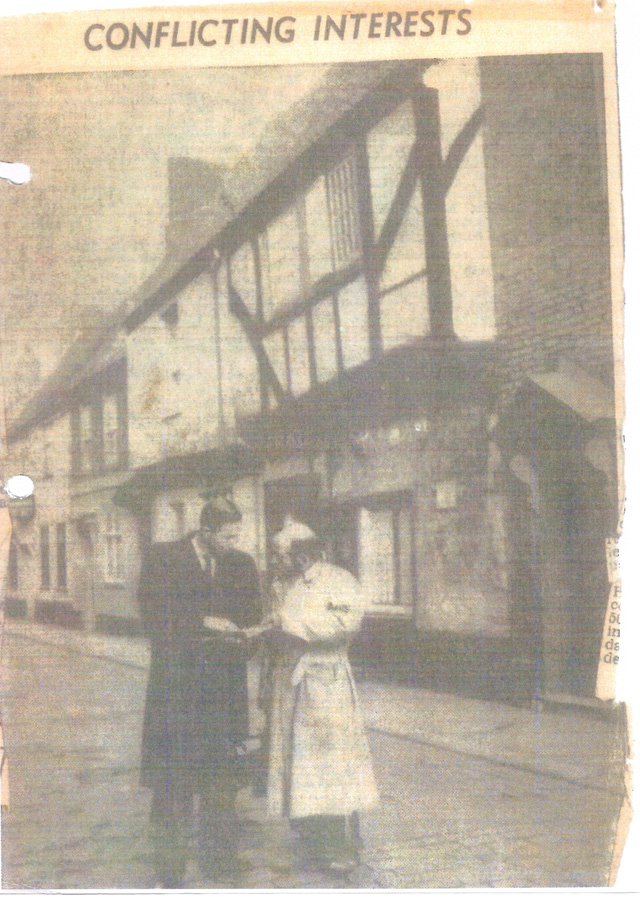
Gustav Metzger meets the president of the Chamber of Trade in Pilot Street, 1958, from Lynn News and Advertiser.
Sadly, the campaign failed and the John Kennedy road was built. All that remains of the North End is a few cottages, now the True’s Yard Museum, and about a third of Pilot Street. However, this failure of politics let Metzger to turn his attention to the power of art to potentially change the world.
He made his first auto-destructive art work, painting with acid on to nylon, in King’s Lynn.
He would return to this technique throughout the 60s and, most importantly, in public settings. At his Acid Action Painting event in 1961 on the South Bank London, he attacked a 7ft x 12ft sheet of nylon with an acid-filled spray gun; the resulting, almost instant, corrosion being a visceral demonstration of the power of his auto-destructive concepts. His statement that “auto-destructive art is an attack on capitalist values and the drive to nuclear annihilation” (23 June 1961) references not only events witnessed in the North End, but his increasing concern with the nuclear threat.
Shortly after the destruction of the North End, Metzger moved to London and developed a type of art that he called “public art for industrial societies”. This art used the actual methods and materials of our industrialised society; he laid out his ideas in manifestos – “The artist may collaborate with scientists, engineers. Self-destructive art can be machine produced and factory assembled.” (4 November 1959) The manifestos contain some of the first references in Britain to the use of computers as possible materials and techniques in art. In 1961, he wrote: “Auto-destructive and auto-creative art aim at the integration of art with the advances of science and technology. The immediate objective is the creation with the aid of computers, of works of art whose movements are programmed and include ‘self-regulation’.” His plan for such a work – the computer-controlled public artwork Five Screens with Computer, was ambitious in concept and scale. With the study of cybernetics, the artist was able to move from oil paint to the use of cybernetic principles of feedback, control and communication, and combine this with his social ideals for a public art.
Metzger called it his “biggest project ever proposed”; it consisted of five walls/frames 40ft long, 30ft high and 2ft deep spaced 25ft apart. Five Screens, he wrote, was to be located in a “very densely populated block of flats in a country setting” and was intended to reflect and reference the inhabitants’ lives, and indeed to form an integral part of their environmental experience. Five Screens had steel, glass or plastic elements that would eject from the walls at intervals based on feedback from the nearby inhabitants, and was ultimately set to destroy itself.
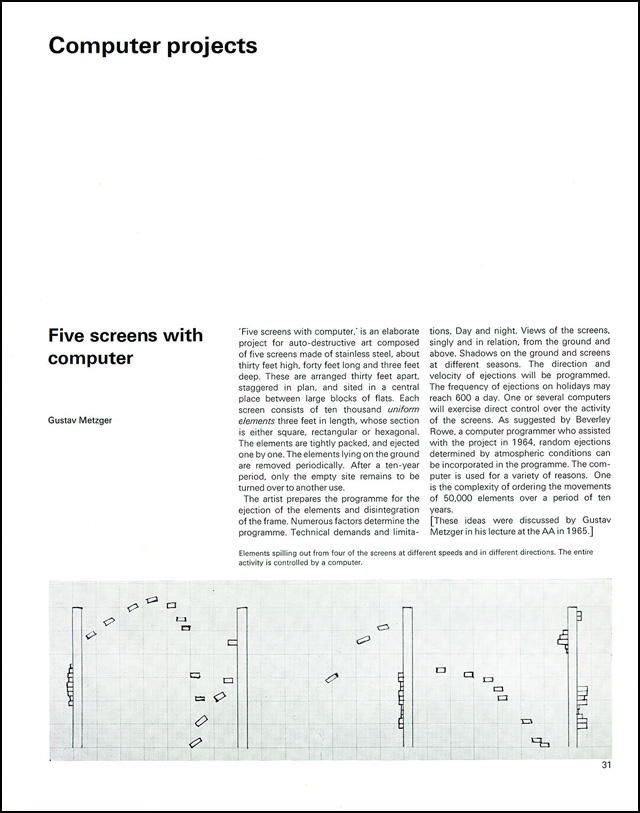
Page 31 from Studio International special issue Cybernetic Serendipity: The Computer and the Arts, July 1968, showing Gustav Metzger & Beverly Rowe’s sketch for Five Screens with Computer, 1969.
Due to prohibitive cost (not to mention modern health and safety considerations), Five Screens remained unrealised at his death. However a drawing was included in the Cybernetic Serendipity catalogue published by Studio International in 1968 (see above). A year later, a metal model was exhibited at the Computer Arts Society’s show Event One at the Royal College of Art.
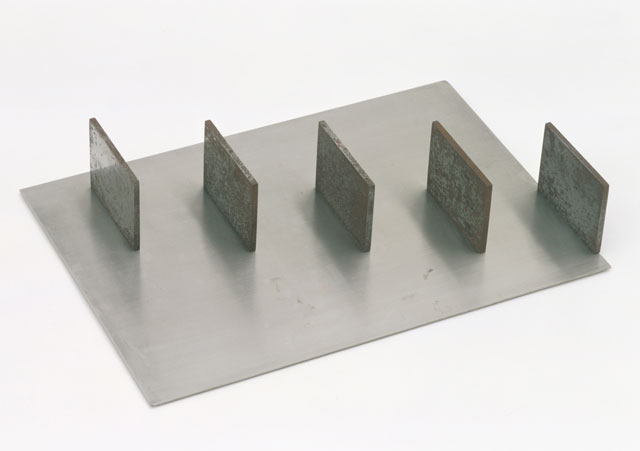
Five Screens with Computer, 1969. Model, Computer-controlled Auto-Destructive monument. Steel, 7.2 x 44.4 x 30.9 cm. Donation by Alan Sutcliffe and Gustav Metzler. Generali Foundation Collection - Permanent Loan to the Museum der Moderne Salzburg © Generali Foundation, Photo: Werner Kaligofsky.
Metzger was an early member of The Computer Arts Society (CAS), officially founded in 1969, and the first practitioner-led organisation in Britain created to promote the creative use of computers in the arts. CAS provided encouragement, inspiration, support of a technical and occasionally financial nature and, perhaps most crucially, access to expertise and equipment, as the group contained participants from technical and scientific backgrounds. Remembering that time, Metzger told me in 2003 that he was “excited” to discover CAS and “people coming together” as he had previously “felt quite isolated”.
For Event One at the Royal College of Art (1969), Metzger collaborated with Dr Beverly Rowe from the University of London Computing Centre and they managed to produce several computer plotter drawings of the project, although the goal of simulating the monument in operation eluded them because of the primitive digital tools available at that time.
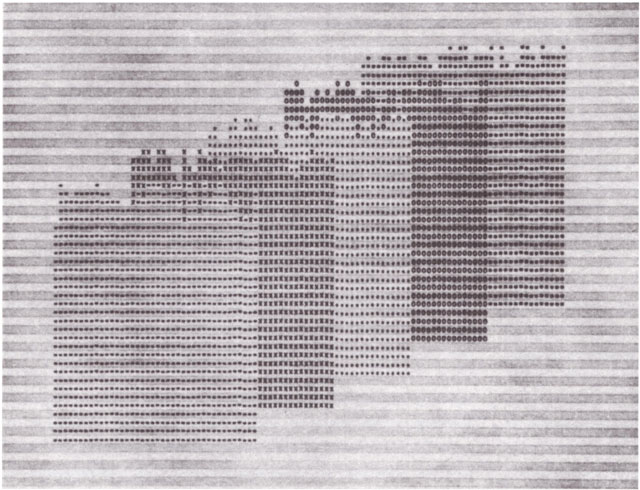
Gustav Metzger & Beverly Rowe, Design study for Five Screens with Computer, March 1969. Computer generated drawing.
At the invitation of CAS co-founder Alan Sutcliffe, Metzger became the first editor of its bulletin Page. Page featured the work of major British and international computer artists, as well as hosting fundamental discussions as to the aims and nature of such art. Metzger was the first member to actively remind fellow members of the potential dangers of technology, warning against any alignment with corporations that might manipulate the direction of the society. Metzger saw computer art as having vast potential, but recognised the responsibility of the artist in using such equipment. He was very aware of what he called “the central and irresoluble dilemma” of technological art – that the origins of much computing technology grew out of predominately war-oriented projects. Within recent memory was the Cuban missile crisis and the still-raging Vietnam war. In several papers, including two published in Studio International (March and October 1969), he called for artists to align themselves with scientists fighting the system from within – such as The British Society for Social Responsibility in Science (whose president, Maurice Wilkins, had worked on the Manhattan Project) and The Union of Concerned Scientists.
Metzger was active in the CAS, participating in many events until his death in 2017. Like others in the CAS, he was unafraid to show work in progress or experimental work as he wished to facilitate cooperation and sharing of knowledge and resources. This position put him at odds with the mainstream art world – the inter-related network of dealer-gallery-auction house that is the capitalist model. Indeed, he actively sought to make work that resisted sale or collection, but this has meant that, until recently, his work has been somewhat overlooked by art history. A book is coming out next year (Gustav Metzger: Writings, JRP|Editions) bringing together all his texts – more than 350, edited by Mathieu Copeland, that will go a long way toward an overdue recognition of Metzger’s influential vision.